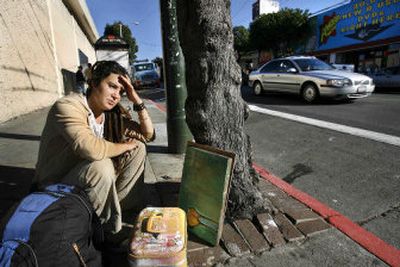Cleaning up San Francisco defies diversity

SAN FRANCISCO – An effort to clean up some of the city’s seedier neighborhoods and rid the streets of junkies, hookers and runaways has run headlong into San Francisco’s free-to-be-who-you-are ethos.
Nearly four decades after the Summer of Love, residents and merchants frustrated with what they regard as blight are turning to the city for help or taking revitalization into their own hands.
But other residents of the Tenderloin district and Haight-Ashbury contend a crackdown would rob their neighborhoods of their identity and violate everything San Francisco stands for.
Joey Cain, a board member of the Haight-Ashbury Neighborhood Council, complained that those who would drive the vagrants from the neighborhood are turning their backs on the Haight’s “historic obligation” to shelter the downtrodden.
This is, after all, the city that proved so appealing to the Beats, the hippies and practically every other brand of noncomformist.
Haight-Ashbury was the very capital of the Summer of Love in 1967, when young people flocked for the music, sexual freedom and drug culture. They are still coming, panhandling on corners and sleeping under the trees in nearby Golden Gate Park.
But the neighborhood has changed. Its stately Victorian homes sell for millions, and the head shops are mixed with chain stores and trendy cafes. Business owners and longtime residents complain that street kids harass the elderly and leave playgrounds littered with needles.
“There is definitely a tension in the neighborhood between the people who live here and the scene on the street,” said Gary Frank, owner of Haight Street’s Booksmith shop since 1976.
Earlier this year, the city decided to enforce an ordinance that makes overnight camping in Golden Gate Park a misdemeanor. It gave 200 homeless people time to remove their belongings; they were paired with social workers who advised them on how to find housing.
But an online neighborhood message board was soon filled with diatribes accusing the city of pandering to well-to-do residents and abandoning its principles.
Cain, the Haight-Ashbury community leader, said those who want to drive the homeless out are simply trying to keep real estate prices high.
Other parts of the Bay Area are feeling similar tensions. In Berkeley’s People’s Park, site of historic 1960s protests, the University of California has proposed eliminating the grassy hills where the homeless have long congregated. Critics complain the plan would destroy what makes the park special.
In the Tenderloin district, San Francisco’s seediest quarter with its flophouses, strip clubs and sex shops, a community group wanted to plant hundreds of trees and enlisted an organization that helps homeless young people to do the work.
But the beautification project angered some gay and transgender residents.
Pamphlets were handed out deriding the proposal, and a picture of the community group’s chairwoman, Carolynn Abst, was featured on “Wanted” posters accusing her of heading a “brutal gentrification squad.”
Those who want to preserve the grittiness of the Tenderloin point with disgust at San Francisco’s Mission District, where in the late 1990s the working-class, mostly Hispanic residents were pushed out by rich dot-com employees.
Abst said opposition to the tree-planting effort was driven by a small group of gay activists. She said she was stunned by the personal attack over what she saw as a good-faith cleanup effort.
San Francisco’s image as a city that accepts all comers “is everybody’s initial good idea,” Abst said. “But over time it wears thin. There is always a new wash of people coming here for the first time and you are cleaning up their bathroom habits.”